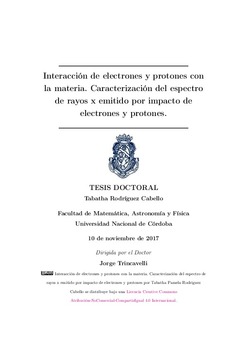| dc.contributor.advisor | Trincavelli, Jorge Carlos | |
| dc.contributor.author | Rodríguez Cabello, Tabatha Pamela | |
| dc.date.accessioned | 2017-12-22T16:10:18Z | |
| dc.date.available | 2017-12-22T16:10:18Z | |
| dc.date.issued | 2017-11-10 | |
| dc.identifier.uri | http://hdl.handle.net/11086/5758 | |
| dc.description | Tesis (Doctor en Física)--Universidad Nacional de Córdoba, Facultad de Matemática, Astronomía, Física y Computación, 2017. | es |
| dc.description.abstract | Se estudiaron espectros de rayos x de transiciones atómicas hacia las capas L, generados por impacto de electrones, en Fe, Ni, Ru, Ag y Te, utilizando para el análisis el software POEMA. Se determinaron parámetros atómicos correspondientes a las líneas de diagrama (energías características, probabilidades relativas de transición, anchos naturales y de niveles atómicos). Se estudiaron además líneas satélites y emisiones Auger radiativas. Por otro lado se creó el programa PAMPA (Parameter Assessment method for PIXE Analysis), para el análisis de espectros de rayos x generados por impacto de protones (PIXE). Este programa permite realizar el ajuste de un espectro, minimizando las diferencias cuadráticas entre el espectro experimental y una función analítica utilizada para describirlo, mediante el refinamiento de parámetros tanto atómicos como experimentales. Se analizaron espectros de PIXE de film delgados y muestras gruesas con el programa PAMPA. Los resultados obtenidos para las concentraciones se compararon con las de referencia y con cuantificaciones realizadas utilizando el software GUPIX, obteniendo un buen acuerdo | es |
| dc.description.abstract | We studied L shells x-ray spectra induced by electron impact, in Fe, Ni, Ru, Ag and Te, using the software POEMA for the analysis. Atomic parameters corresponding to the diagram lines were determined characteristic energies, relative transition probabilities, natural linewidths and atomic levels widths). No diagram lines, such as satellite lines and radiative Auger emissions were also studied. On the other hand, the program PAMPA (Parameter Assessment Method for PIXE Analysis) for the analysis of x-ray spectra generated by protons impact (PIXE) was developed. This program allows for the fitting of a spectrum by minimizing the quadratic differences between the experimental spectrum and an analytical function used to describe it, through the refinement of atomic and experimental parameters. Thin films and thick samples were analyzed. The results obtained for the concentrations agree well with the reference concentrations and with quantifications made using the well-known GUPIX software. | en |
| dc.language.iso | spa | es |
| dc.rights | Atribución-NoComercial-CompartirIgual 4.0 Internacional. | |
| dc.rights.uri | https://creativecommons.org/licenses/by-nc-sa/4.0/ | |
| dc.subject | X-ray and γ-ray spectrometers | es |
| dc.subject | Atomic excitation and ionization | es |
| dc.subject | Atomic spectra | es |
| dc.subject | Intensities and shapes of atomic spectral lines | es |
| dc.subject.other | Espectros de rayos X | es |
| dc.subject.other | Líneas L | es |
| dc.subject.other | Parámetros atómicos | es |
| dc.subject.other | PIXE | es |
| dc.subject.other | Cuantificación sin estándares | es |
| dc.title | Interacción de electrones y protones con la materia. Caracterización del espectro de rayos x emitido por impacto de electrones y protones | es |
| dc.type | bachelorThesis | es |





